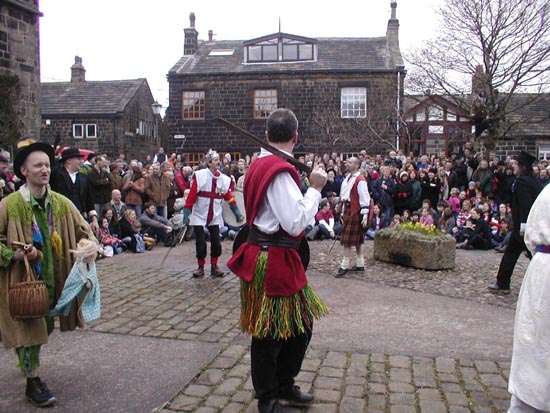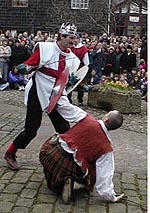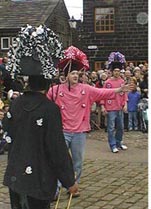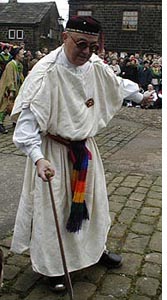Pace Egging: A Lancashire Tradition
by John Ravenscroft
When I first heard the term Pace Egging I thought it probably had something to do with drunken villagers rolling eggs down steep English hillsides -- we Brits do things like that with all kinds of items, including cheeses, barrels of beer and significant others -- but I was wrong. Apparently the word "Pace" is nothing to do with the relative speeds of competitive egg-rollers. The truth is far more mundane. "Pace" comes from the Latin "Pacha" which means Easter, and Pace Egging is just one more of our many and varied Easter Traditions.

It dates back hundreds of years, perhaps as far as The Crusades, and has been recorded in several counties, including Lancashire, Yorkshire and Northumberland. It does indeed involve eggs: special Pace Eggs that are decorated for the Easter festival. In the past these eggs were wrapped in onionskins and carefully boiled (a practice that gave their shells an appearance of mottled gold) but in more recent times they're simply hard-boiled and then painted. The William Wordsworth Museum at Grasmere displays a small collection of Pace Eggs that were originally decorated for William's children -- but don't just go for the eggs. You'll find plenty of daffodil-related material there, too.
 Traditionally -- before paint replaced onionskin -- Pace Eggs were part of the Easter Sunday breakfast, but if they weren't eaten they might be used as household ornaments, in various egg-games, or given to bands of performers known as Pace Eggers, who were once a common sight in northern English villages. Like many traditions, Pace Egging suffered a decline in popularity and at one point was on the brink of extinction -- but in recent years it has been revived. Happily, the Pace Eggers are back! Traditionally -- before paint replaced onionskin -- Pace Eggs were part of the Easter Sunday breakfast, but if they weren't eaten they might be used as household ornaments, in various egg-games, or given to bands of performers known as Pace Eggers, who were once a common sight in northern English villages. Like many traditions, Pace Egging suffered a decline in popularity and at one point was on the brink of extinction -- but in recent years it has been revived. Happily, the Pace Eggers are back!
In previous centuries, Pace Eggers were groups of locals who toured the villages at Easter enacting The Pace Egging Play. This was a drama that usually involved a character representing St. George, a battle, and an interesting individual known as Old Tosspot. It invariably detailed someone's unfortunate death (in some versions it's St. George, in others it's a Turkish Knight called Bold Slasher) and his subsequent revival by a comic doctor.
The Pace Eggers (alternatively known as Jolly Boys) were variously disguised. Old Tosspot would blacken his face with soot (a practice that in more recent times has been copied by other characters), and some players wore masks. All had decorated costumes.
 Old Tosspot's job was to collect gifts from the crowd. He carried a woven basket over one arm, and had a long straw tail that was full of sharp pins. He would swing this about, and anyone who tried to grab it would be painfully pricked by the pins. Old Tosspot would encourage the wounded (and any other onlookers) to toss gifts into his basket. Pace Eggs, coins, food, Old Tosspot didn't much care. Old Tosspot's job was to collect gifts from the crowd. He carried a woven basket over one arm, and had a long straw tail that was full of sharp pins. He would swing this about, and anyone who tried to grab it would be painfully pricked by the pins. Old Tosspot would encourage the wounded (and any other onlookers) to toss gifts into his basket. Pace Eggs, coins, food, Old Tosspot didn't much care.
When the basket was full enough, the Pace Eggers would begin their Easter Play.
There were several versions of it, and different villages added different elements. The banter with the crowd was also incorporated, so every performance was slightly different. However, the core of the play always centred around some aspect of death and rebirth.
If the Pace Eggers were performing outside the village pub (which they often were) they could look forward to an extra payment in the form of a free pint of beer and a kiss from the barmaid.
Old Tosspot was an interesting chap, but of course there were other characters in the Pace Egging Play. They varied from year to year and decade to decade, but might include The Lady Gay, the Soldier Brave, The Noble Youth, The Doctor, Betty Brownbags, Bold Slasher, The Fool, and (later) Lord Nelson.
The Pace Eggers would perform their play at several points throughout the village, generally concluding each performance with one version or another of the Pace Egging Song:
Here's one or two Jolly Boys, all of one mind
We've come a Pace-Egging, and hope you'll prove kind
We hope you'll prove kind with your eggs and strong beer
And we'll come no more nigh you until next year.
Sometimes more than one band of Pace Eggers toured the same village, and if they were to meet the watching crowd might be treated to an extra spectacle - the trading of a few ripe insults, a wooden sword fight or two, and (in the worst of these encounters) low and cowardly attempts to steal the rival group's Pace Eggs! It's been suggested that the trading of insults on these occasions may be where the expression "to egg someone on" originated.
Pace Egging Today
 Although it was noted as early as 1842 that the Pace Egging Play was being performed less and less frequently, the revival of interest in English folk customs after the Second World War helped to rekindle enthusiasm. Although it was noted as early as 1842 that the Pace Egging Play was being performed less and less frequently, the revival of interest in English folk customs after the Second World War helped to rekindle enthusiasm.
Midgley School (and later Calder Valley High School) in West Yorkshire played an important part in saving the tradition of Pace Egging, and Calder Valley High still puts on performances of the play every Good Friday.
The costumes worn by some modern-day groups of Pace Eggers are traditional and local, but during the 1960s folk festivals became popular, and members of the English Folk Revival Movement ran a number of drama workshops that used time-honoured scripts and themes to bring Mummers Plays back to life. These workshops appear to have had an influence on what some well-dressed Pace Eggers now wear during their performances.
There are groups of Pace Eggers scattered throughout the UK, so anyone interested in seeing a performance has a choice of locations.
Heptonstall in West Yorkshire is a popular venue, but be warned, the tiny village can get very crowded. The landlords of the two local pubs don't complain, though. They do rather well out of Heptonstall's Pace Egging Day!
There are also performances at Brighouse, Broughton in Furness (Cumbria), and Bury in Lancashire. See the further information links for dates, times and venues.
Egg Rolling
I said in my introduction that Pace Egging has nothing to do with egg-rolling, but I was wrong. In the course of researching this article I discovered that Pace Eggs are still rolled down quite a few English hillsides. At Avenham Park in Preston there's an annual egg-rolling contest that attracts large crowds. Children compete to see who owns the sturdy Pace Egg that can roll the furthest without cracking. If your children take part, however, make sure they're aware of the dangers. Legend has it that empty Pace Egg shells must be carefully destroyed by crushing. It seems that, if they're left in a half-decent state of repair, Lancashire witches will steal them and use them as boats!
Related Articles:
- A Taste of Easter, by Dawn Copeman
- https://www.timetravel-britain.com/articles/taste/easter.shtml
More Information:
We regret that we no longer have the resources to maintain up-to-date links and/or hours and pricing details for the various sites and attractions listed on this website. For more information about the location(s) listed above, please use your favorite search engine or visit Wikipedia.
John Ravenscroft is a teacher-turned-writer who lives in Lincolnshire, England. He spends much of his time struggling to write fiction and co-editing Cadenza Magazine. His short stories have won prizes in various literary competitions and been published in numerous magazines, and his work has also been broadcast on the BBC. In 2005 he is planning to write more nonfiction articles. Visit his website at http://www.johnravenscroft.co.uk.
Article © 2005 John Ravenscroft
Photos © Duncan Broomhead
| 